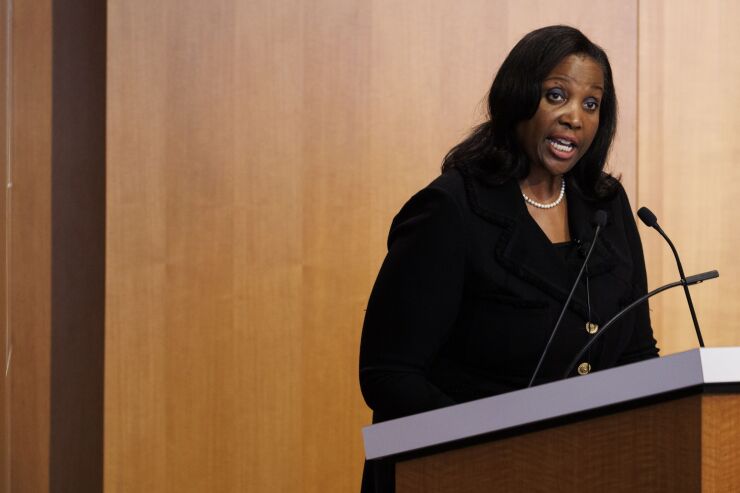
Last fall I went to a conference sponsored by the National Bankers Association, a trade group representing minority depository institutions, in Washington. It was a two-day affair, and as far as I could tell I was the only journalist in the room — usually a sign that not much was going to happen. But I was wrong.
The lineup for the conference included some of the heaviest hitters in banking regulation. Acting Comptroller of the Currency Michael Hsu and Federal Deposit Insurance Corp. Chair Martin Gruenberg
That's a pretty stacked lineup, I thought, for a conference focused on the needs and wants of MDIs and CDFIs, and signified to me the prominence that this administration envisions for those institutions. And indeed, CDFIs are having something of a moment.
Federal Reserve Gov. Lisa Cook this morning
In other words, CDFIs — at least as far as this administration is concerned — are the good guys. In politics everybody's a good guy, and they will happily tell you so. Oil companies are creating good-paying jobs that keep us from being dependent on unfriendly countries for our vital energy needs. Defense manufacturers make sure our soldiers and sailors have the tools they need to keep us safe from foreign aggression. Banks help keep our economy strong and help households and businesses meet their financial goals. Tobacco companies give consumers the rich, smooth tobacco flavor that generations of Americans have come to rely upon.
But we all know these industries can be portrayed in a less flattering light — and often far, far less flattering. One way industries manage that reputational risk is to differentiate themselves from their icky cousins, as small banks have done for decades by insisting they are not at all like their very large competitors (or as credit unions have done with banks). CDFIs seem to have sufficiently differentiated themselves from other lenders of any type or size in two important ways: being present in the markets that need financial services the most and for which there is the least competition, and being focused by charter on lending to those communities rather than being maximally profitable.
What the support for CDFIs ultimately does, however, is allow these institutions — which include banks, credit unions, venture capital firms and others — to apply for various grants, bond guarantees and other vehicles to backstop different kinds of lending or services for specific kinds of borrowers or communities. But, as Cook pointed out, "while there has been an influx of federal funding for CDFIs, much of that is tied to pandemic-related relief programs and other programs with specific purposes. Therefore, building out long-term sources of capital is a continuing challenge."
One solution Cook cited is expanding and systematizing the secondary market for CDFI-originated loans. The New York Fed's annual
That's an awful lot of windup, so here's the pitch: Expanding CDFIs' working capital and giving them the resources they need to do the good work they are doing is a good use of public resources, but when secondary markets enter the chat I get a little nervous.
Secondary markets — that is, making a loan and then selling it, giving you the capital to make more loans and offloading the risk of the loan you just made — can be a lucrative business. But it also can create the conditions where a loan originator is indifferent to the outcome of the loan and incentivized only to make more loans to sell to someone else, especially if there is a sense that loans are guaranteed and demand is unquenchably high.
The idea that CDFIs might be out there pushing, say, small-dollar loans on people who don't need them just to make a quota is ridiculous because they're CDFIs — they're the good guys, they would never do such a thing. But the good guys have a way of becoming the bad guys when there is money to be made — an institutional label provides little protection against greed.
None of this is to say that CDFIs' work is unacceptably risky or unworthy of support — it most certainly is. But if the problem is that CDFIs' lending activities are insufficiently scaled — that they could do more with more — then turning to secondary markets will either create scale at the expense of community value or retain community value at the expense of scale.






